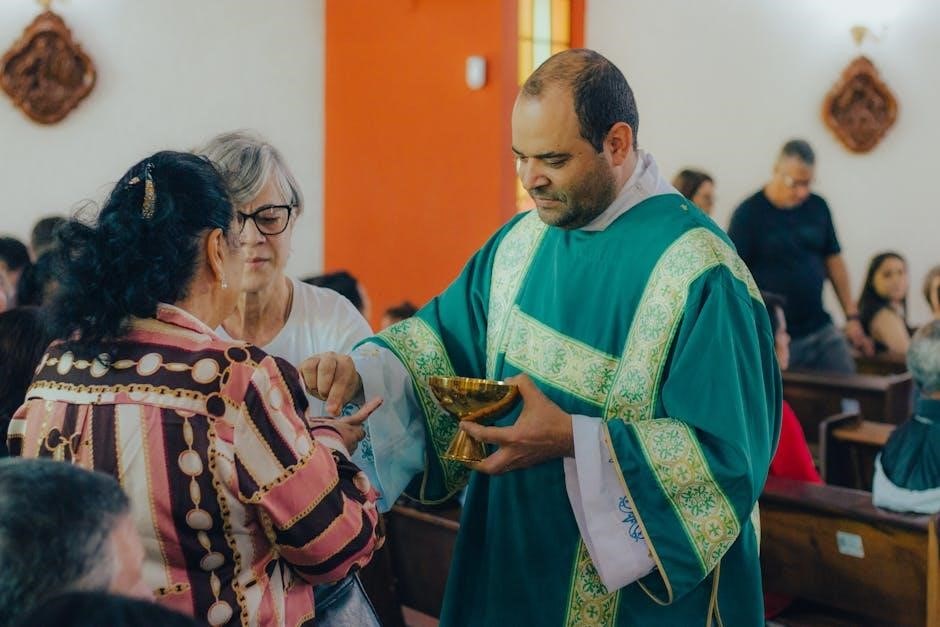The Good Friday liturgy commemorates Christ’s Passion, featuring the Liturgy of the Word, Veneration of the Cross, and Holy Communion, reflecting deep solemnity and devotion.
Overview of the Significance of Good Friday

Good Friday is a solemn and deeply significant day in the Catholic Church, commemorating the crucifixion and death of Jesus Christ. It is the apex of Holy Week, reflecting on Christ’s ultimate sacrifice for humanity’s redemption. The liturgy emphasizes mourning, gratitude, and spiritual reflection, inviting believers to unite with Christ’s Passion. This day is not a celebration but a profound observance of love and sacrifice, preparing the faithful for Easter’s resurrection. The liturgy’s structure and traditions underscore the gravity of Christ’s death, offering a universal moment of prayer and devotion for Catholics worldwide.
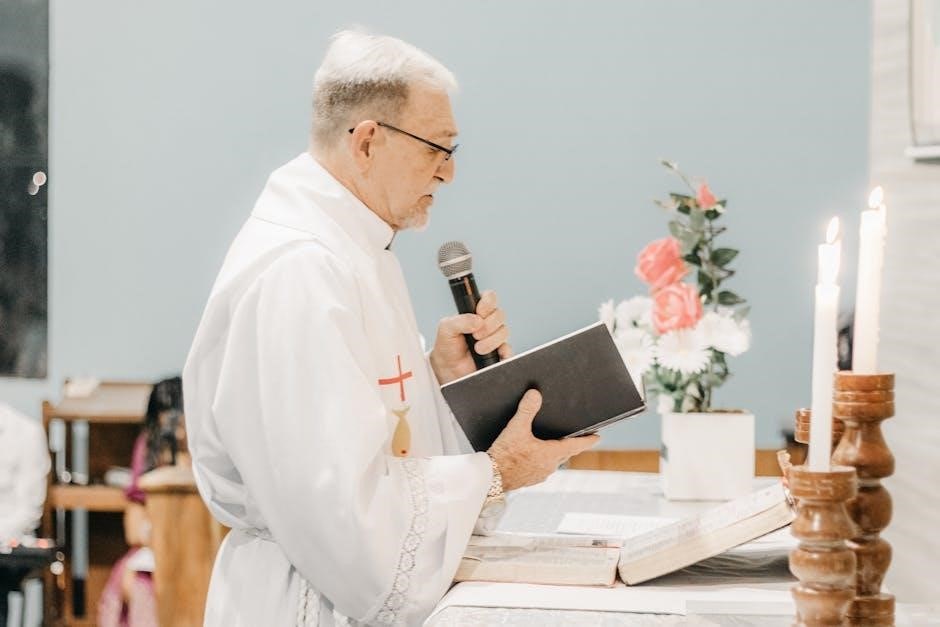
Structure of the Good Friday Liturgy
The Good Friday liturgy is divided into three distinct parts: the Liturgy of the Word, the Adoration of the Holy Cross, and Holy Communion. The service begins with a silent gathering, emphasizing solemnity and reflection. The Liturgy of the Word includes readings from Scripture, the Passion narrative from John’s Gospel, and solemn intercessions, highlighting Christ’s sacrifice. The Adoration of the Cross follows, where the congregation venerates the crucifix, symbolizing their devotion and gratitude. Finally, Holy Communion is distributed using hosts consecrated on Holy Thursday, as no Mass is celebrated on Good Friday. This structure reflects the Church’s reverence for Christ’s Passion and death, fostering a spirit of prayer and penance among the faithful.

The Liturgy of the Word on Good Friday
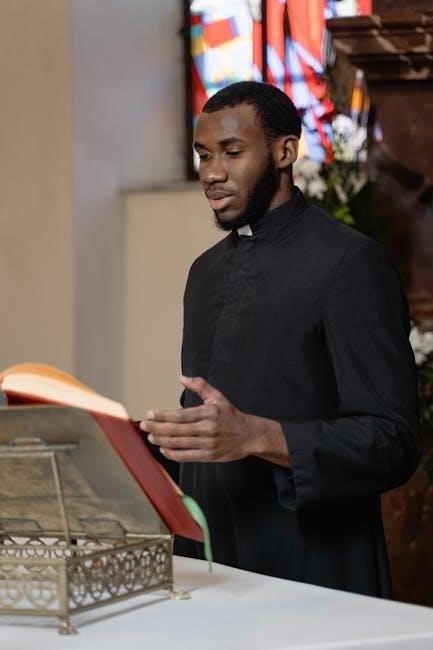
The Liturgy of the Word on Good Friday includes readings from Isaiah, Hebrews, and the Passion narrative from John’s Gospel, followed by solemn intercessions, focusing on Christ’s sacrifice.
Readings and Their Significance
The readings on Good Friday are deeply symbolic, beginning with Isaiah 52:13-53:12, which prophesies Christ’s suffering and redemption. Hebrews 4:14-16 and 5:7-9 highlight Jesus’ role as the High Priest, offering the perfect sacrifice. The Gospel, John 18:1-19:42, vividly recounts the Passion, emphasizing Christ’s love and obedience. These readings illuminate the theological depth of Christ’s sacrifice, preparing the congregation for the liturgy’s solemn rituals. Their interconnection underscores redemption, mercy, and the Paschal mystery, inviting believers to reflect on the cost of salvation and the triumph of love over sin.
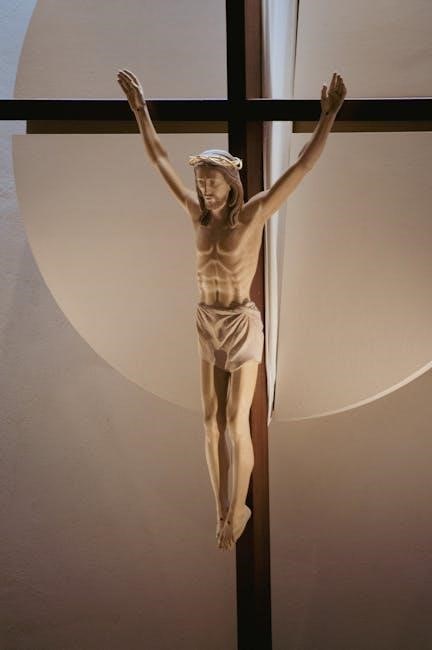
The Passion Narrative from John’s Gospel
The Passion Narrative from John’s Gospel (John 18:1–19:42) is a focal point of the Good Friday liturgy, recounting Christ’s arrest, trial, crucifixion, and death. This dramatic reading, often divided into parts (Narrator, Jesus, and Other Speakers), underscores the sacrificial love of Jesus. Key moments include His prayer in the Garden of Gethsemane, the betrayal by Judas, the trials before Annas and Pilate, and the crucifixion. The narrative highlights Jesus’ divine authority and redemptive purpose, culminating in His final words, “It is finished.” The congregation participates by assuming roles, evoking a deep sense of solidarity with the events. This reading invites reflection on the mystery of salvation and the triumph of love over sin. It is a profound meditation on the cost of redemption and the heart of Christian faith.
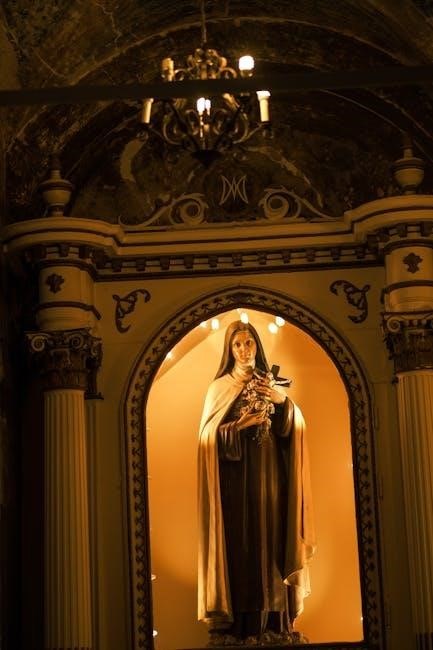
The Adoration of the Holy Cross
The Adoration of the Holy Cross is a solemn ceremony where the cross is venerated as a symbol of Christ’s sacrifice. The congregation participates in silent prayer and veneration, reflecting on the redemption won through Christ’s crucifixion.
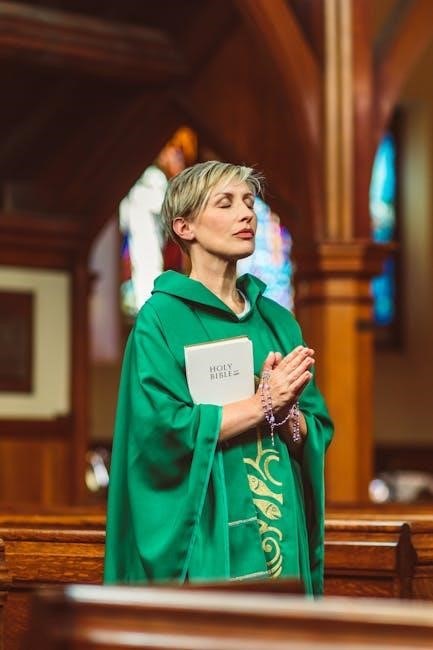
Traditions and Practices Surrounding the Veneration
The veneration of the Holy Cross is a deeply rooted tradition in the Catholic Church, observed on Good Friday. The cross, often unveiled gradually, symbolizes Christ’s sacrifice. The congregation approaches the cross to kiss or touch it, expressing devotion and gratitude. This practice, known as the “Adoration of the Cross,” is accompanied by prayers and hymns, emphasizing the redemption won through Christ’s crucifixion. The ceremony is conducted in silence or with solemn music, fostering a contemplative atmosphere. The cross is treated with reverence, reflecting the Church’s belief in its power to sanctify and bring spiritual strength to the faithful.
The Role of the Congregation in the Ceremony
The congregation plays a vital role in the Good Friday liturgy, actively participating through prayer, song, and veneration. They kneel during the entrance in silence, engaging in personal reflection. The faithful respond to prayers and join in chanting, demonstrating unity with Christ’s Passion. Many also participate in the veneration of the cross, showing reverence by kissing or touching it. The congregation’s involvement emphasizes their connection to the Church’s sacramental life. Silent prayer and communal intercessions further highlight their active engagement. This shared worship fosters a deep sense of solidarity, inviting believers to reflect on Christ’s sacrifice and its significance in their lives. Their participation is essential to the liturgy’s solemn and transformative nature.
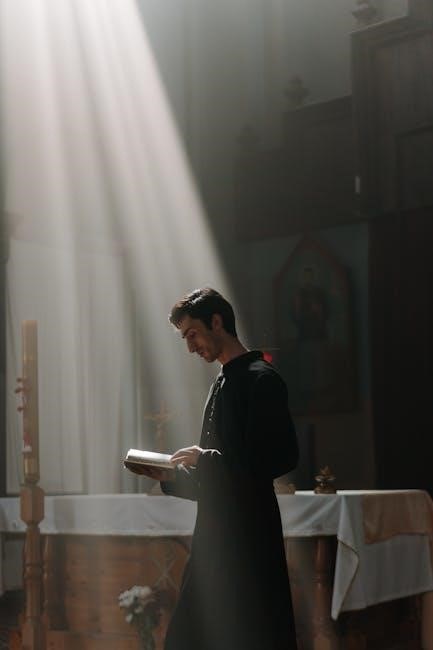
Holy Communion on Good Friday

The consecrated hosts for Holy Communion on Good Friday are prepared during Holy Thursday’s Mass. They are distributed to the faithful during the Good Friday liturgy.
Distinctive Features of the Eucharistic Rite
The Eucharistic Rite on Good Friday is unique, as no consecration occurs during the service. The hosts distributed are those consecrated during Holy Thursday’s Mass. The rite begins with a solemn procession to the altar, where the pre-consecrated hosts are presented. The Eucharistic Prayer is omitted, and the service focuses on the distribution of Communion as a remembrance of Christ’s sacrifice. The rite is marked by simplicity and solemnity, reflecting the day’s somber nature. This distinctive approach underscores the Church’s tradition of preserving the Eucharist from the previous day, emphasizing the unity of the Triduum celebrations. The faithful participate in silent reflection, deepening their devotion to Christ’s Passion.
Preparation and Distribution of Consecrated Hosts
The consecrated hosts used on Good Friday are prepared during Holy Thursday’s Mass, as no consecration occurs on Good Friday. These hosts are reverently stored in a place of repose, symbolizing the Altar of Repose. During the Good Friday liturgy, the hosts are solemnly brought to the altar in a procession, accompanied by silent prayer. The priest then distributes the hosts to the faithful, kneeling as a sign of reverence. This practice emphasizes the unity of the Triduum and the continuity of Christ’s sacrifice. The distribution is a poignant reminder of the Eucharist’s connection to the Passion, fostering a deep sense of devotion among the congregation.
Prayer and Devotion on Good Friday
Prayer and Devotion on Good Friday are marked by silent reflection, solemn hymns, and the congregation’s active participation in venerating the Holy Cross and receiving Communion.
Special Prayers and Hymns Used in the Liturgy
Special prayers and hymns are integral to the Good Friday liturgy, fostering a somber and reflective atmosphere; The Collect for Good Friday, a solemn prayer, invokes God’s mercy and grace. Hymns like O Sacred Head, Now Wounded and Were You There evoke deep devotion. These prayers and hymns, often chanted or sung, emphasize Christ’s sacrifice and humanity’s redemption. They are carefully chosen to align with the liturgical readings, enhancing the congregation’s spiritual experience. The liturgy also includes the Mass of the Presanctified, where consecrated hosts from Holy Thursday are distributed, symbolizing the Eucharist without consecration. This tradition underscores the sacred nature of the day, focusing on prayer, penance, and communal worship.
The Role of Silent Prayer and Reflection
Silent prayer and reflection are central to the Good Friday liturgy, fostering a somber and contemplative atmosphere. The service begins with ministers entering in silence, followed by a period of kneeling for silent prayer, inviting the congregation to reflect on Christ’s sacrifice. This silence emphasizes the gravity of the day, allowing the faithful to interiorize the mystery of the Passion. Moments of stillness punctuate the liturgy, encouraging deeper spiritual engagement. The Tenebrae service, often held in the early morning or late at night, further incorporates prolonged silent prayer, symbolizing the darkness of Christ’s death. These practices help the congregation connect with the liturgy on a profound level, fostering a spirit of penance and devotion.
Good Friday’s liturgy profoundly reflects on Christ’s sacrifice, uniting the faithful in solemn observance, deepening devotion, and renewing commitment to Christian faith and values.
Final Reflections on the Good Friday Liturgy
The Good Friday liturgy offers a profound spiritual experience, inviting believers to reflect on Christ’s ultimate sacrifice. Through the Liturgy of the Word, the Veneration of the Cross, and Holy Communion, the faithful reconnect with the Savior’s love and redemption. The solemnity of the occasion, marked by silence and prayer, creates a sacred space for introspection and renewal. As the Church remembers Christ’s Passion, it unites in mourning and hope, awaiting the joy of Easter. This liturgy deepens devotion, fostering a commitment to live out the Christian faith with compassion and humility, inspired by Christ’s selfless love.
